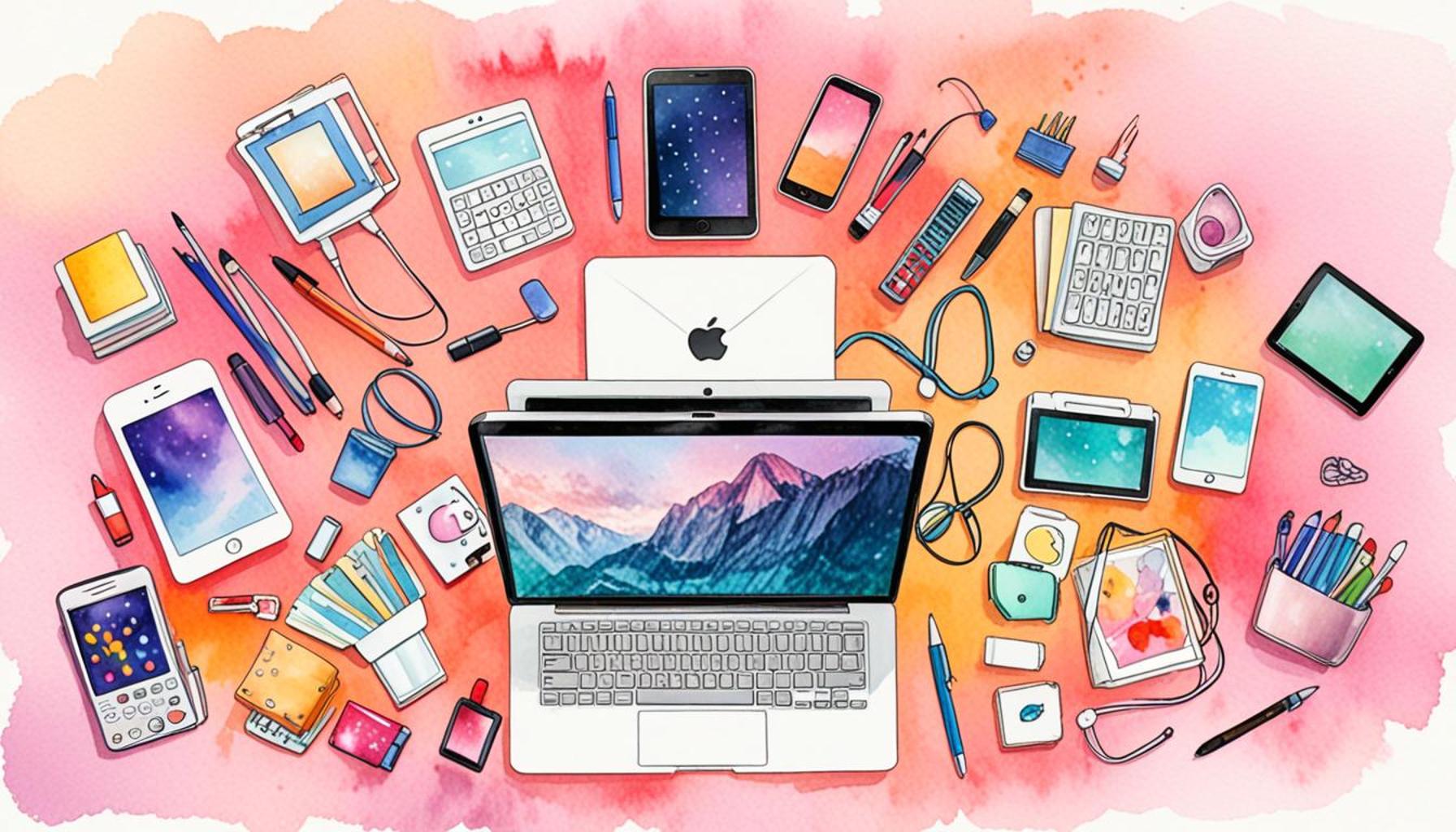Practical Strategies for Efficient Digital Decluttering: Step-by-Step to Organize Your Devices

Transform Your Digital Space
In today’s fast-paced digital world, our devices often become cluttered with unnecessary files, notifications, and apps. This overwhelming digital clutter can hamper productivity and even increase stress levels. Understanding effective strategies for digital decluttering is essential to reclaiming your time and enhancing your focus.
Why Digital Decluttering Matters
Start by recognizing the benefits of digital decluttering:
- Improved Efficiency: Organized devices run smoother and faster. For example, removing redundant apps and cleaning out your email inbox can decrease load times and streamline your workflow significantly.
- Increased Focus: Less visual clutter leads to better concentration. Studies show that a clear digital workspace can enhance cognitive function, allowing you to tackle tasks with greater efficiency.
- Enhanced Security: Reducing obsolete data minimizes susceptibility to cyber threats. Outdated applications and unused software can create vulnerabilities; therefore, maintaining a clean digital space also protects sensitive information.
With countless apps, photos, and documents vying for your attention, it’s crucial to approach decluttering systematically. This article will guide you through practical, step-by-step strategies focused on organizing your devices.
Getting Started
Prepare to embark on your decluttering journey by considering the following:
- Identify Priorities: Know what files and applications are essential. This could be apps that help manage your personal finances, or vital documents related to your work projects. Make a list to ensure you don’t overlook what truly matters.
- Set Time Limits: Allocate specific times to declutter your devices. For instance, designating just 15 minutes a day can lead to remarkable improvements over a week, making the process less daunting and more manageable.
- Adopt Regular Maintenance: Create a routine to keep your digital space organized. Establish a weekly ritual where you review and remove irrelevant files, ensuring that your digital environment remains productive and clutter-free.
By taking these actionable steps, you’ll pave the way to a more efficient and less stressful digital experience, turning your devices into streamlined tools that enhance your daily life. Whether it’s keeping your smartphone organized or regularly backing up important documents, small changes can result in significant benefits. In embracing these practices, you can cultivate a digital workspace that empowers creativity and fosters productivity, ultimately improving both your professional and personal endeavors.

DIVE DEEPER: Click here to discover how to simplify your online life
Step-by-Step Guide to Digital Decluttering
To embark on your digital decluttering journey effectively, it’s important to break the process down into manageable steps. While tackling the entire landscape of your digital space may seem daunting, approaching it methodically can transform your devices into tools of productivity rather than sources of stress.
1. Assess Your Digital Landscape
The first step in your decluttering process is to conduct a comprehensive assessment of your devices. Make a list of all apps, files, and folders currently residing on your devices, including your desktop computer, laptop, smartphone, and tablet. This will not only give you a clear picture of your digital clutter but will also help you identify items that are no longer needed.
2. Categorize Your Clutter
Once you’ve assessed your digital landscape, begin categorizing your clutter into the following groups:
- Essential: These are files and applications that you use daily and cannot do without. Examples include productivity tools like Microsoft Office, important email accounts, or photo editing software.
- Useful: Items in this category are used occasionally, but still hold value. These may include reference materials, seasonal apps, or files related to ongoing projects.
- Redundant: This includes duplicate files, outdated applications, and documents you haven’t touched in months. These are prime candidates for deletion and should be addressed first.
- Unnecessary: Identify things that serve no purpose. Perhaps old games, unused subscriptions, or relics from long-closed accounts. These can be removed without any regret.
3. Tackle One Device at a Time
When it comes to digital decluttering, focusing on one device at a time can enhance your productivity dramatically. Start with your most-used device, often your smartphone or computer. Here is a straightforward approach to get you started:
- Smartphone: Begin by going through your apps. Delete any that you haven’t opened in the past month. Next, organize essential apps into folders based on categories like ‘Work’, ‘Social’, and ‘Finance’.
- Computer: Open your file explorer and focus on downloading locations and desktop icons. Sort files into neatly labeled folders, and remove duplicates or outdated items. Don’t forget to empty your recycle bin afterward!
- Email Inbox: A cluttered inbox can lead to anxiety and inefficiency. Set aside time to unsubscribe from newsletters you no longer read and categorize or archive emails into relevant folders.
By taking these critical steps — assessing, categorizing, and tackling one device at a time — you will begin to feel the weight of digital clutter lift off your shoulders. Remember, the goal here is not just to clear space but to cultivate an efficient and organized digital environment that can significantly enhance your productivity and well-being.
Practical Strategies for Efficient Digital Decluttering
As we delve deeper into the vast digital landscape, efficient management of our devices becomes increasingly crucial. Digital decluttering is not just about tidying up; it’s about creating a seamless and functional digital environment that enhances productivity and mental clarity. Here are some actionable strategies to help you take control of your digital space.
1. Assess and Prioritize Your Digital Assets
Before diving into the decluttering process, it is essential to take inventory of your existing digital assets. This includes files, applications, emails, and even subscriptions. Categorize them into ‘essential’, ‘important’, and ‘unnecessary’. By identifying what truly matters to you, you can prioritize your resources effectively and make informed decisions on what to keep and what to discard.
2. Streamline Your Applications and Tools
Many people use various applications that overlap in functionality. Take the time to evaluate which apps you actually use and how they contribute to your daily tasks. Consider consolidating your tools; for instance, replace multiple project management apps with a single comprehensive solution. This not only saves space but also helps in reducing mental clutter.
3. Establish a Regular Schedule for Maintenance
Just as you clean your physical space regularly, your digital realm requires the same attention. Set aside time each month to review your digital assets, deleting what you no longer need and organizing what you choose to keep. Consider creating recurring reminders or calendar events that prompt you to declutter your downloads, photos, and emails.
4. Utilize Cloud Storage Solutions
Cloud storage can significantly alleviate the burden on your devices. By transferring files to cloud platforms, you can free up local storage while maintaining easy access. Additionally, many cloud services offer shared folders and collaborative spaces, enhancing teamwork and streamlining workflows.
5. Optimize Your Digital Workflow
Incorporate tools like automation software or task schedulers to maximize efficiency. By automating repetitive tasks, you not only declutter your workload but also allocate your time towards more meaningful activities. Explore integrations between applications that allow for seamless data sharing and task management.
Enhancing Productivity through Digital Decluttering
Implementing these strategies will transform your digital environment and significantly boost productivity. As you work through your decluttering journey, remember that it’s a continual process of evaluation and adjustment. Embrace the challenge, and witness how a well-organized digital space can lead to enhanced focus and improved mental well-being. To encapsulate the advantages of efficiently decluttering your digital resources, refer to the table below, detailing key benefits and characteristics associated with effective digital organization.
| Category | Key Benefits |
|---|---|
| Time Management | Elimination of distractions leads to more focused work sessions. |
| Mental Clarity | An organized digital environment promotes better decision-making. |
| Increased Productivity | Streamlined processes allow for quicker task completion. |
With these principles in mind, you can embark on a path toward a more efficient and organized digital life. Embrace the process and reclaim your digital space, fostering a more productive and harmonious virtual existence. Remember, the journey to effective digital decluttering starts with the first step.
DIVE DEEPER: Click here to discover mindfulness and minimalism techniques
4. Implement Organization Systems
Having assessed your digital landscape and removed unnecessary items, it’s time to implement organization systems that will prevent clutter from accumulating again. Creating a structured framework is essential for maintaining efficiency in your digital environment. Here are some effective strategies to keep things organized:
- Folder Hierarchy: Create a logical folder hierarchy on your devices where files are easily accessible. Begin with broad categories, such as ‘Work’, ‘Personal’, and ‘Finance’, and then subdivide these categories into more specific folders. For example, your ‘Work’ folder could contain subfolders for ‘Projects’, ‘Client Files’, and ‘Reports’. Adopting a systematic naming convention will also enhance searchability.
- Cloud Storage Solutions: Utilize cloud storage services like Google Drive, Dropbox, and OneDrive to keep essential files accessible from any device. Not only does this safeguard against data loss, but it also frees up local storage space. Regularly review and back up your files to ensure everything is secure and organized.
- Digital To-Do Lists: Maintain a digital to-do list or productivity app to track important tasks and deadlines. Tools like Trello, Todoist, or Microsoft To Do can help you organize your priorities while seamlessly integrating with your email and calendar services to streamline your workflow.
5. Set Regular Decluttering Sessions
The key to a long-term solution for digital clutter is establishing a habit of regular maintenance. Designating time to declutter periodically helps to keep your digital space organized over the long haul. Here are some tips to consider:
- Monthly Cleanup: Schedule monthly or bi-monthly sessions specifically dedicated to decluttering. During these sessions, go through your files, apps, and emails to identify what needs to be removed or organized. Setting a calendar reminder can help you stick with this commitment.
- End-of-Project Reviews: After completing a project, conduct a brief review of the files and folders associated with it. This is the time to archive important documents while deleting the rest. This ensures that project-related clutter doesn’t linger in your digital space.
- One-In, One-Out Rule: Adopt the ‘One-In, One-Out’ principle, which suggests that for every new app or file you add, you should remove one. This principle encourages you to be more selective about what you allow into your digital space, significantly reducing future clutter.
6. Optimize Your Search Capabilities
Efficient search capabilities can aid in navigating and managing your digital space. Most devices and platforms offer various features to enhance search functionality. Understanding and leveraging these features can save time and reduce frustration:
- Smart Search Filters: Investigate filtering options available in file explorers, email clients, and apps to quickly locate specific documents or correspondence. For example, email services like Gmail allow for advanced search operators that can narrow results based on dates, keywords, or attachments.
- Desktop Search Tools: Explore desktop search tools like Alfred for Mac or Everything for Windows to expedite local searches. These applications index your files, allowing for rapid searching across various formats and locations with minimal effort.
- Bookmark Management: Don’t forget about your web browsers! Regularly review and organize your bookmarks. Create folders for different topics or interests, and periodically eliminate bookmarks that are no longer pertinent or useful.
Embracing these advanced organizational systems, setting maintenance schedules, and optimizing your search capabilities not only aids in the decluttering process but also fosters a more productive digital ecosystem. The result is a smartly organized digital landscape where technology becomes an authentic ally in your daily endeavors.
DISCOVER MORE: Click here to learn how to harmonize your
Conclusion
Embarking on a journey of digital decluttering can seem daunting, yet the rewards are profoundly transformative. By implementing practical strategies for efficient digital decluttering, you’ll not only enhance the organization of your devices but also pave the way for improved productivity and mental clarity. From establishing a structured folder hierarchy to leveraging cloud storage solutions, each step taken serves to create a cohesive digital ecosystem. Regular maintenance through scheduled decluttering sessions ensures that the successes achieved are sustainable, preventing a return to chaos.
The importance of optimizing search capabilities cannot be understated. Utilizing smart search filters and dedicating attention to bookmark management can save time, reducing frustration while navigating your digital landscape. As you adopt these strategies, consider how they create a new relationship with your technology, where efficiency and accessibility reign. Ultimately, a thoughtfully organized digital space allows you to reclaim control over your daily tasks, transforming technology from a source of stress into a facilitator of productivity.
As you venture forward, remember that digital decluttering is an ongoing process, not a one-time event. Continually reassessing your digital habits and practices will guide you toward a streamlined, effective environment that supports your goals. Encourage yourself to be proactive and creative with your approach, and watch as your digital life becomes more harmonious and efficient.


